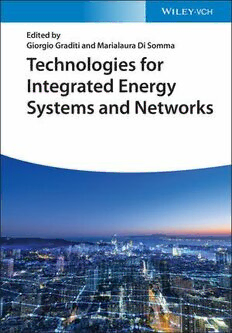
Technologies for Integrated Energy Systems and Networks PDF
Preview Technologies for Integrated Energy Systems and Networks
TechnologiesforIntegratedEnergySystemsandNetworks Technologies for Integrated Energy Systems and Networks Edited by Giorgio Graditi and Marialaura Di Somma TheEditors AllbookspublishedbyWILEY-VCHarecarefully produced.Nevertheless,authors,editors,and Dr.GiorgioGraditi publisherdonotwarranttheinformation ItalianNationalAgencyforNew containedinthesebooks,includingthisbook, Technologies tobefreeoferrors.Readersareadvisedtokeep EnergyandSustainableEconomic inmindthatstatements,data,illustrations, Development proceduraldetailsorotheritemsmay ENEA,DepartmentofEnergy inadvertentlybeinaccurate. TechnologiesandRenewableSources Rome,Italy LibraryofCongressCardNo.:appliedfor Dr.MarialauraDiSomma BritishLibraryCataloguing-in-PublicationData ItalianNationalAgencyforNew Acataloguerecordforthisbookisavailable Technologies fromtheBritishLibrary. EnergyandSustainableEconomic Development Bibliographicinformationpublishedby ENEA,DepartmentofEnergy theDeutscheNationalbibliothek TechnologiesandRenewableSources TheDeutscheNationalbibliothekliststhis Rome,Italy publicationintheDeutscheNationalbiblio- grafie;detailedbibliographicdataareavailable CoverImage:©zfL/GettyImages ontheInternetat<http://dnb.d-nb.de>. ©2022WILEY-VCHGmbH,Boschstr.12, 69469Weinheim,Germany Allrightsreserved(includingthoseof translationintootherlanguages).Nopartof thisbookmaybereproducedinanyform–by photoprinting,microfilm,oranyothermeans– nortransmittedortranslatedintoamachine languagewithoutwrittenpermissionfromthe publishers.Registerednames,trademarks,etc. usedinthisbook,evenwhennotspecifically markedassuch,arenottobeconsidered unprotectedbylaw. PrintISBN: 978-3-527-34899-2 ePDFISBN: 978-3-527-83361-0 ePubISBN: 978-3-527-83362-7 oBookISBN: 978-3-527-83363-4 Typesetting Straive,Chennai,India Printedonacid-freepaper 10 9 8 7 6 5 4 3 2 1 v Contents 1 ChallengesandOpportunitiesoftheEnergyTransitionand theAddedValueofEnergySystemsIntegration 1 MarialauraDiSommaandGiorgioGraditi 1.1 EnergyTransformationTowardDecarbonizationandtheAddedValueof EnergySystemsIntegration 1 1.2 EuropeanUnionastheGlobalLeaderinEnergyTransition 6 1.3 PillarsfortheTransitionTowardIntegratedDecentralizedEnergy Systems 11 ListofAbbreviations 13 References 13 2 IntegratedEnergySystems:TheEngineforEnergy Transition 15 MarialauraDiSommaandGiorgioGraditi 2.1 Introduction:theConceptofIntegratedEnergySystem 15 2.2 KeyEnablersforIntegratedEnergySystems 18 2.2.1 StorageandConversionTechnologies 18 2.2.2 EndUserEngagementandEmpowerment 22 2.2.3 DigitalizationEnabler 24 2.2.4 EmergenceofanIntegratedEnergyMarket 27 2.3 IntegratedEnergySystemsattheLocalLevel 28 2.3.1 ConceptualizingLocalIntegratedEnergySystems 28 2.3.2 MapofEnablingTechnologies 29 2.3.3 KeyStakeholdersandRelatedBenefitsfromLocalIntegratedEnergy SystemsDeployment 31 2.4 MainBarriersforImplementation 33 2.4.1 Techno-economicBarriers 34 2.4.2 SocioeconomicBarriers 35 2.4.3 PolicyandRegulatoryBarriers 35 2.5 Conclusions 36 ListofAbbreviations 38 References 38 vi Contents 3 PowerConversionTechnologies:TheAdventofPower-to-Gas, Power-to-Liquid,andPower-to-Heat 41 JoshuaA.Schaidle,R.GaryGrim,LingTao,MarkRuth,KevinHarrison, NancyDowe,ColinMcMillan,ShantiPless,andDouglasJ.Arent 3.1 Introduction 41 3.1.1 MotivationforPower-to-X 41 3.1.2 DefiningPower-to-XCategories 43 3.1.3 GoalofthisChapter 44 3.2 Power-to-XTechnologies 44 3.2.1 Power-to-Gas 44 3.2.1.1 NaturalGasMarketDemand 45 3.2.1.2 TechnologyIdentificationandOverview 46 3.2.1.3 UniqueIntegrationChallengesandOpportunities 47 3.2.2 Power-to-Chemicals-and-Fuels 48 3.2.2.1 MarketandDemand 48 3.2.2.2 TechnologyIdentificationandOverview 49 3.2.2.3 UniqueIntegrationChallengesandOpportunities 54 3.2.2.4 ImplicationsonPowerGeneration 54 3.2.3 Power-to-Heat 57 3.2.3.1 MarketandDemand 57 3.2.3.2 TechnologyIdentificationandOverview 60 3.2.3.3 UniqueIntegrationChallengesandOpportunities 60 3.2.3.4 ImplicationsonPowerGeneration 62 3.3 OverarchingChallenges,Opportunities,andConsiderations 62 3.3.1 FeedstockandEnergySourcing 62 3.3.1.1 Feedstocks(CO ,N ,H O,andBiomass) 62 2 2 2 3.3.1.2 OperationalFlexibilityforGridIntegrationandRevenue 63 3.3.2 KeyConsiderationsfromLifeCycleAnalysisandTechno-economic Analysis 64 3.3.2.1 LifeCycleAnalysis 64 3.3.2.2 Techno-EconomicAnalysis 64 3.3.3 BusinessModelandBusinessInnovation 65 3.4 ConcludingRemarks 66 Disclaimer 66 ListofAbbreviations 66 References 67 4 RoleofHydrogeninLow-CarbonEnergyFuture 71 AndreaMonfortiFerrario,VivianaCigolotti,AnaMarìaRuz,FelipeGallardo, JoseGarcía,andGiuliaMonteleone 4.1 Introduction 71 4.2 MainDriversforHydrogenImplementation 72 4.2.1 IncreasingPenetrationofStochasticRenewableEnergy 73 4.2.2 OpportunityofHydrogenasaSectorCouplingEnabler 74 4.3 HydrogenEconomyandPolicyinEuropeandWorldwide 74 Contents vii 4.4 MainRenewableHydrogenProduction,Storage,and Transmission/DistributionSchemes 77 4.4.1 HydrogenProductionPathways 77 4.4.2 HydrogenTransmissionandDistribution 79 4.4.2.1 MainHydrogenStorageTechnologies 79 4.4.2.2 MethodsforHydrogenTransmissionandDistribution 81 4.5 TechnologicalApplicationsinIntegratedEnergySystemsand Networks 83 4.5.1 HydrogenasanEnergyStorageSystemforFlexibilityatDifferent Scales 83 4.5.2 IndustrialUseasaRenewableFeedstockinHard-to-AbateSectorsand fortheProductionofDerivates 84 4.5.3 HydrogenMobility:AComplementarySolutiontoBatteryElectric Vehicles 85 4.5.4 FuelCells,FlexibleElectrochemicalConversionSystemsfor High-EfficiencyPower,and/orCHPApplications 86 4.6 Conclusions 89 ListofAbbreviations 90 References 91 5 ReviewontheEnergyStorageTechnologieswiththeFocuson Multi-EnergySystems 105 MortezaVahid-Ghavidel,SaraJavadi,MatthewGough,MohammadS.Javadi, SérgioF.Santos,MiadrezaShafie-khah,andJoãoP.S.Catalão 5.1 Introduction 105 5.2 EnergyStorage 106 5.2.1 MainConceptofEnergyStorageinthePowerSystem 106 5.2.2 DifferentTypesofEnergyStorageSystems 108 5.2.2.1 ElectromechanicalEnergyStorageSystems 110 5.2.2.2 ElectromagneticEnergyStorageSystems 111 5.2.2.3 ElectrochemicalEnergyStorageSystems 112 5.2.2.4 ThermalEnergyStorageSystems 113 5.2.3 AdvantagesofStorageintheEnergySystem 113 5.3 EnergyStorageTechnologyApplicationintheMulti-Energy Systems 116 5.4 Conclusion 118 ListofAbbreviations 119 References 119 6 DigitalizationandSmartEnergyDevices 123 MaherChebbo 6.1 Introduction 123 6.2 OurVisionoftheDigitalNetworks 130 6.3 EnablingState-of-the-ArtDigitalTechnologies 138 6.4 KeyDigitalUseCasesandAssociatedBenefits 144 viii Contents 6.5 IntegratedDigitalPlatformAcrossStakeholders 149 6.6 KeyDigitalRecommendations 150 6.7 Conclusion 156 ListofAbbreviations 159 References 160 FurtherReading 162 7 SmartandSustainableMobilityAdaptationTowardtheEnergy Transition 165 CarlaSilva,CatarinaMarques,MarianaRaposo,andAngeloSoares 7.1 SmartandSustainableMobilityDefinitionsandMetrics 165 7.1.1 SustainableMobilityKPI(KeyPerformanceIndicators) 167 7.1.2 KPIofUrbanMobilityinTwoEuropeanCities 169 7.2 SmartMobilityAppliedtoBicycleSharinginUrbanContextandImpacts onSustainability 175 7.3 Ground-LevelOzoneIndicator 178 7.4 EnergyTransition 179 7.5 ResilienceoftheMobilitySystem 180 7.6 Conclusions 182 Acknowledgments 182 ListofAbbreviations 183 References 184 8 EvolutionofElectricalDistributionGridsTowardtheSmart GridConcept 187 LucíaSuárez-Ramón,PabloArboleya,JoséLorenzo-Álvarez,and JoséM.Carou-Álvarez 8.1 SmartGridConcept 187 8.2 AdvancedMeteringInfrastructure(AMI)GeneralDescription 188 8.3 CommunicationsandImpactonRemoteManagement 199 8.3.1 PLCPRIMECommunication 200 8.3.2 DataConcentratorUnit(DCU)Description 204 8.3.3 SmartMeterDescription 205 8.3.4 FutureScenario:EvolutionofCommunicationsTowardHybrid Systems 206 8.4 CentralSystemforDataReceptionandAnalysis 206 8.4.1 Real-TimeEventManagement 207 8.4.2 LVNetworkMonitoring 208 8.4.3 AutomaticDiagnostic 208 8.5 DSOChallenge:AMIforLVNetworkManagement 209 8.6 DigitalTwinoftheLVNetwork 210 8.7 EvolutionoftheFunctionalitiesforLVNetworkManagement 212 8.8 Conclusions 213 ListofAbbreviations 213 References 214 Contents ix 9 SmartGridsfortheEfficientManagementofDistributed EnergyResources 215 RobertoCiavarella,MarialauraDiSomma,GiorgioGraditi,andMariaValenti 9.1 ElectricalSystemTowardtheSmartGridConcept 215 9.1.1 TechnologyAreasofSmartGrids 218 9.1.2 ServicesandFunctionalitiesoftheSmartGrids 219 9.1.2.1 NeedstoIntegrateNewEmergingTechnologies 220 9.1.2.2 ImprovetheOperationoftheNetwork 220 9.1.2.3 NewInvestmentPlanningCriteria 220 9.1.2.4 ImprovetheFunctionalityoftheMarketandServicestoEndUsers 220 9.1.2.5 ActiveInvolvementoftheEndUser 221 9.1.2.6 IncreasedEnergyEfficiencyandReducedEnvironmentalImpact 221 9.2 NeedofaMulti-DomainOptimizationinSmartGrids 221 9.3 AdvancedControlMechanismsforSmartGrid 225 9.3.1 ArchitectureandGridModel 225 9.3.2 CongestionIssuesintheTSODomain 226 9.3.3 CongestionIssuesintheDSODomain 228 9.3.4 FrequencyInstabilityintheTSODomain 230 9.4 CaseStudies 231 9.4.1 CaseStudy1:CongestionEventsattheTransmissionLevel 231 9.4.2 CaseStudy2:CongestionEventsattheDistributionLevel 232 9.4.3 CaseStudy3:FrequencyInstabilityIssues 233 9.5 Conclusions 234 ListofAbbreviations 235 References 235 10 NearlyZero-EnergyandPositive-EnergyBuildings:Statusand Trends 239 DeniaKolokotsa,GloriaPignatta,andGiuliaUlpiani 10.1 Introduction 239 10.1.1 ConceptofNearlyZero-andPositive-EnergyBuildings 240 10.1.1.1 Definitions,Regulations,andStandards 240 10.1.2 OverviewofDesignStrategies 242 10.1.2.1 EnergyConservationStrategies 243 10.1.2.2 EnergyGenerationStrategies 246 10.1.2.3 SmartReadiness 248 10.2 StatusandResearchDirectionsonHigh-PerformanceBuildingsfor theComingDecade 253 10.2.1 OverviewofCaseStudiesandResearchProjects 253 10.2.1.1 Challenges,Drivers,andBestPractices 256 x Contents 10.2.2 TransitionfromIndividualNearlyZero-EnergyBuildingsto Positive-EnergyDistricts(PEDs) 258 10.3 Conclusions 259 ListofAbbreviations 260 References 261 11 TransitionPotentialofLocalEnergyCommunities 275 GabrieleComodi,GianlucaSpinaci,MarialauraDiSomma,and GiorgioGraditi 11.1 Introduction 275 11.1.1 “2030AgendaforSustainableDevelopment”ofUnitedNations 276 11.1.2 CleanEnergyforAllEuropeanPackage:RenewableandCitizen“Energy Communities” 277 11.1.3 HumanCapitalforLocalEnergyCommunities 278 11.1.4 LocalEnergyCommunities:AnOrganizationalBottom-UpModelto EmpowerFinalUsers 279 11.2 LocalEnergyCommunitiesMakingtheGreenDealGoingLocal 280 11.2.1 GameChangeroftheGreenDeal 280 11.2.2 GreenDealGoingLocal 283 11.2.3 NeighborhoodApproachandLocalEnergyCommunitiesintheGreen Deal 284 11.3 LocalEnergyCommunitiesasIntegratedEnergySystemsatLocal Level 285 11.3.1 LocalEnergyCommunitiesasPromotersforSectorCoupling 285 11.3.2 OptimalMedium–Long-TermPlanningforLocalEnergy Communities 287 11.3.3 KeyTechnologiesintheContextofLocalEnergyCommunities 288 11.3.4 DigitalizationtoEnableFlexibilityandEmpowerFinalUsers 296 11.4 LocalEnergyCommunitiesandEnergyTransition:AVisionfortheNext Future 298 11.4.1 SomeReflections 299 11.5 Conclusions 300 ListofAbbreviations 301 References 302 Index 305 1 1 Challenges and Opportunities of the Energy Transition and the Added Value of Energy Systems Integration MarialauraDiSommaandGiorgioGraditi ItalianNationalAgencyforNewTechnologies,EnergyandSustainableEconomicDevelopment,ENEA, DepartmentofEnergyTechnologiesandRenewableSources,Rome,Italy 1.1 Energy Transformation Toward Decarbonization and the Added Value of Energy Systems Integration Theglobalenergytransformationisalreadyinplace,andthisrepresentsthemain replyofhumanitytosafeguardglobalclimateandmaintainsustainableexistenceon Earth.Thefirststeptowardthisenergytransformationandtheinternationalcom- mitmenttocombatingclimatechange,increasingenergyaccess,andmaintaining biodiversityisrepresentedbytheParisAgreementsigningatCOP21withthegoal ∘ to maintain global warming lower than 2 C above the pre-industrial levels. Con- current to the Paris Agreement, countries committed to the United Nations (UN) 17 Sustainable Development Goals (SDGs), representing the plan toward a better worldforpeopleandourplanettobeachievedby2030[1].Tacklingclimatechange isatransversalgoalforalmostallSDGs.Althoughtheinternationalcommitmentis evident,challengesstillremainforthesuccessfulimplementationoftheParisAgree- ment and climate- and energy-related SDGs, and the gap between aspiration and realityincombatingclimatechangeremainssignificant. Meeting these ambitious goals requires the commitment beyond the electricity sector,whereasprovidingdecarbonizationacrossdifferentsectorsthroughaninte- gratedapproachcanrepresentavalidsolution.Thisisthemainideabehindthecon- ceptofIntegratedEnergySystemsthat,accordingtotheETIPSNETVision2050[2], aredefinedasanintegratedinfrastructureforallenergycarriers,withtheelectrical system as the backbone. These systems are characterized by a high level of inte- grationamongallnetworksofenergycarriersobtainedthroughcouplingelectrical andgasnetworks,heating,andcooling,supportedbyenergystorageandconversion processes.Couplingdifferentsectorsindicatesincreasingeffortsinasynergicway bycoordinatingtheplanningandtheoperationofenergysystemsacrossmultiple energycarrierswhilealsoachievingamoreflexible,reliable,andefficientenergy systemasawhole. Themainenergytrendstowarddecarbonizationarediscussedbelowalongwith theaddedvalueofferedbyenergysystemsintegration. TechnologiesforIntegratedEnergySystemsandNetworks,FirstEdition. EditedbyGiorgioGraditiandMarialauraDiSomma. ©2022WILEY-VCHGmbH.Published2022byWILEY-VCHGmbH.
